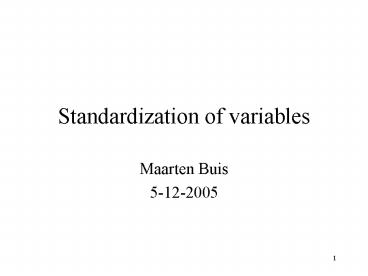Standardization of variables - PowerPoint PPT Presentation
1 / 24
Title:
Standardization of variables
Description:
apart from that all you have to remember is that the formula is complicated ... Both give a distribution with fixed mean, standard deviation, and unit ... – PowerPoint PPT presentation
Number of Views:45
Avg rating:3.0/5.0
Title: Standardization of variables
1
Standardization of variables
- Maarten Buis
- 5-12-2005
2
Recap
- Central tendency
- Dispersion
- SPSS
3
Standardization
- Is used to improve interpretability of variables.
- Some variables have a natural interpretable
metric e.g. income, age, gender, country. - Others, primarily ordinal variables, do not e.g.
education, attitude items, intelligence. - Standardizing these variables makes them more
interpretable.
4
Standardization
- Transforming the variable to a comparable metric
- known unit
- known mean
- known standard deviation
- known range
- Three ways of standardizing
- P-standardization (percentile scores)
- Z-standardization (z-scores)
- D-standardization (dichotomize a variable)
5
When you should always standardize
- When averaging multiple variables, e.g. when
creating a socioeconomic status variable out of
income and education. - When comparing the effects of variables with
unequal units, e.g. does age or education have a
larger effect on income?
6
P-Standardization
- Every observation is assigned a number between 0
and 100, indicating the percentage of observation
beneath it. - Can be read from the cumulative distribution
- In case of knots assign midpoints
- The median, quartiles, quintiles, and deciles are
special cases of P-scores.
7
(No Transcript)
8
P-standardization
- Turns the variable into a ranking, i.e. it turns
the variable into a ordinal variable. - It is a non-linear transformation relative
distances change - Results in a fixed mean, range, and standard
deviation M50, SD28.6, This can change
slightly due to knots - A histogram of a P-standardized variable
approximates a uniform distribution
9
Linear transformation
- Say you want income in thousands of guilders
instead of guilders. - You divide INCMID by f1000,-
10
Linear transformation
- Say you want to know the deviation from the mean
- Subtract the mean (f2543,-) from INCMID
11
Recap multiplication and addition and the number
line
12
Linear transformation
- Adding a constant (X Xc)
- M(X) M(X)c
- SD(X) SD(X)
- Multiply with a constant (X Xc)
- M(X) M(X)c
- SD(X) SD(X) c
13
Z-standardization
- Z (X-M)/SD
- two steps
- center the variable (mean becomes zero)
- divide by the standard deviation (the unit
becomes standard deviation) - Results in fixed mean and standard deviation
M0, SD1 - Not in a fixed range!
- Z-standardization is a linear transformation
relative distances remain intact.
14
Z-standardization
- Step 1 subtract the mean
- c -M(X)
- M(X) M(X)c
- M(X) M(X)-M(X)0
- SD(X)SD(X)
15
Z-standardization
- Step 2 divide by the standard deviation
- c is 1/SD(X)
- M(Z) M(X) c
- M(Z) 0 1/SD(X) 0
- SD(Z) SD(X) c
- SD(Z) SD(X) 1/SD(X) 1
16
Normal distribution
- Normal distribution Gauss curve Bell curve
- Formula (McCall p. 120)
- Note the (x-m)2 part
- apart from that all you have to remember is that
the formula is complicated - Normal distribution occurs when a large number of
small random events cause the outcome e.g.
measurement error
17
Normal distribution
- Other examples the height of individuals,
intelligence, attitude - But the variables Education, Income and age in
Eenzaam98 are not normally distributed
18
Z-scores and the normal distribution
- Z-standardization will not result in a normally
distributed variable - Standardization in NOT the same as normalization
- We will not discuss normalization (but it does
exist) - But If the original distribution is normally
distributed, than the z-standardized variable
will have a standard normal distribution.
19
Standard normal distribution
- Normal distribution with M0 and SD1.
- Table A in Appendix 2 of McCall
- Important numbers (to be remembered)
- 68 of the observations lie between 1 SD
- 90 of the observations lie between 1.64 SD
- 95 of the observations lie between 1.96 SD
- 99 of the observations lie between 2.58 SD
20
Why bother?
- If you know
- That a variable is normally distributed
- the mean and standard deviation
- Than you know the percentage of observations
above or below and observation - These numbers are a good approximation, even if
the variable is not exactly normally distributed
21
P Z standardization
- Both give a distribution with fixed mean,
standard deviation, and unit - P-standardization also gives a fixed range
- Both are relative to the sample if you take
observations out, than you have to re-compute the
standardized variables
22
P Z-standardization
- When interpreting Z-standardized variables one
uses percentiles - With P-standardization one decreases the scale of
measurement to ordinal, BUT this improves
interpretability.
23
Student recap
24
Do before Wednesday
- Read McCall chapter 5
- Understand Appendix 2, table A
- make exercises 5.7-5.28































